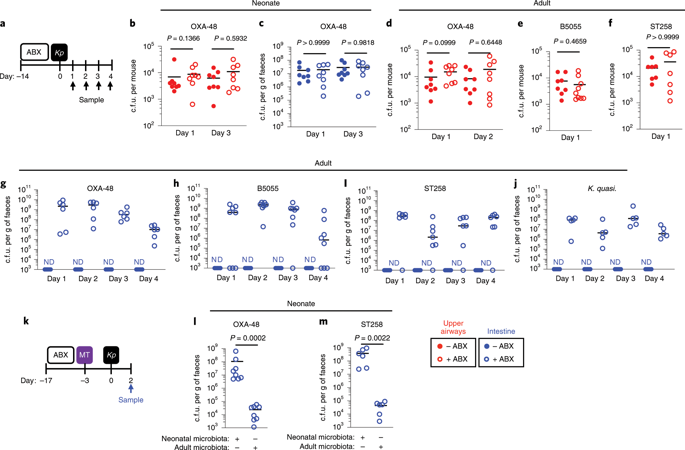Nature Microbiology ( IF 20.5 ) Pub Date : 2020-01-06 , DOI: 10.1038/s41564-019-0640-1 Richard P Sequeira 1 , Julie A K McDonald 2 , Julian R Marchesi 2, 3 , Thomas B Clarke 1

|
The microbiota primes immune defences but the identity of specific commensal microorganisms that protect against infection is unclear. Conversely, how pathogens compete with the microbiota to establish their host niche is also poorly understood. In the present study, we investigate the antagonism between the microbiota and Klebsiella pneumoniae during colonization and transmission. We discover that maturation of the microbiota drives the development of distinct immune defence programmes in the upper airways and intestine to limit K. pneumoniae colonization within these niches. Immune protection in the intestine depends on the development of Bacteroidetes, interleukin (IL)-36 signalling and macrophages. This effect of Bacteroidetes requires the polysaccharide utilization locus of their conserved commensal colonization factor. Conversely, in the upper airways, Proteobacteria prime immunity through IL-17A, but K. pneumoniae overcomes these defences through encapsulation to effectively colonize this site. Ultimately, we find that host-to-host spread of K. pneumoniae occurs principally from its intestinal reservoir, and that commensal-colonization-factor-producing Bacteroidetes are sufficient to prevent transmission between hosts through IL-36. Thus, our study provides mechanistic insight into when, where and how commensal Bacteroidetes protect against K. pneumoniae colonization and contagion, providing insight into how these protective microorganisms could be harnessed to confer population-level protection against K. pneumoniae infection.
中文翻译:

共生拟杆菌通过 IL-36 信号传导防止肺炎克雷伯菌定植和传播
微生物群启动免疫防御,但保护免受感染的特定共生微生物的身份尚不清楚。相反,病原体如何与微生物群竞争以建立其宿主生态位也知之甚少。在本研究中,我们研究了微生物群与肺炎克雷伯菌在定植和传播过程中的拮抗作用。我们发现微生物群的成熟推动了上气道和肠道中不同免疫防御程序的发展,以限制肺炎克雷伯菌在这些生态位内进行殖民化。肠道中的免疫保护取决于拟杆菌、白细胞介素 (IL)-36 信号传导和巨噬细胞的发育。拟杆菌的这种作用需要其保守的共生定殖因子的多糖利用位点。相反,在上呼吸道,变形杆菌通过 IL-17A 启动免疫,但肺炎克雷伯菌通过包裹克服这些防御,有效地定殖该位点。最终,我们发现肺炎克雷伯菌的宿主间传播主要来自其肠道储库,产生共生定植因子的拟杆菌足以防止宿主之间通过 IL-36 传播。因此,我们的研究提供了对共生拟杆菌何时、何地以及如何防止肺炎克雷伯菌定植和传染的机制洞察,提供了对如何利用这些保护性微生物来提供针对肺炎克雷伯菌感染的群体水平保护的洞察力。










































 京公网安备 11010802027423号
京公网安备 11010802027423号